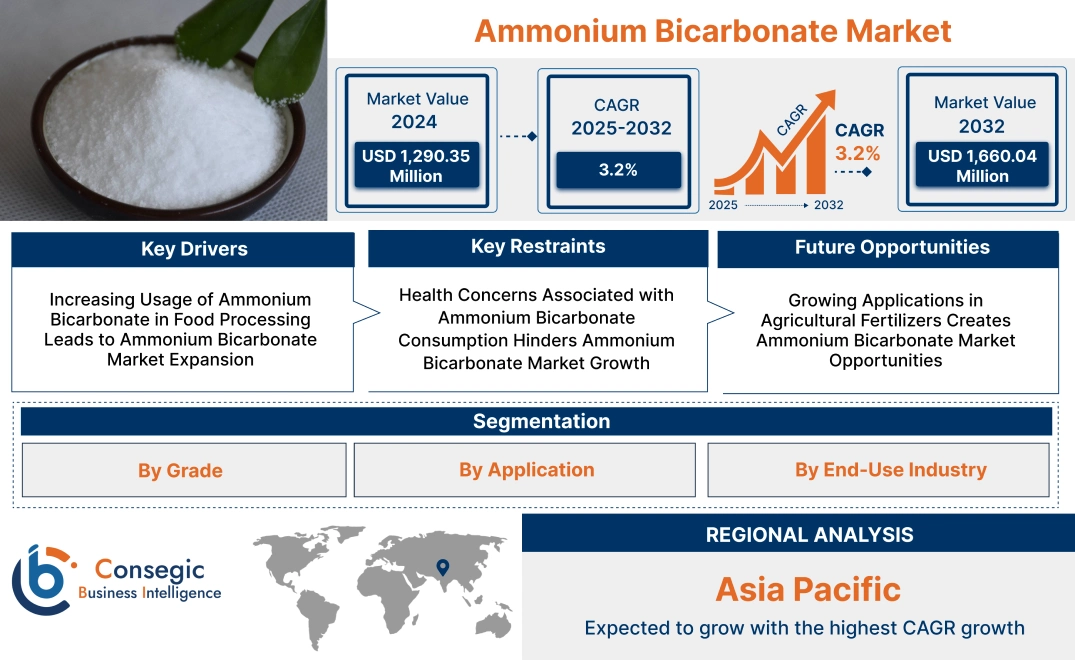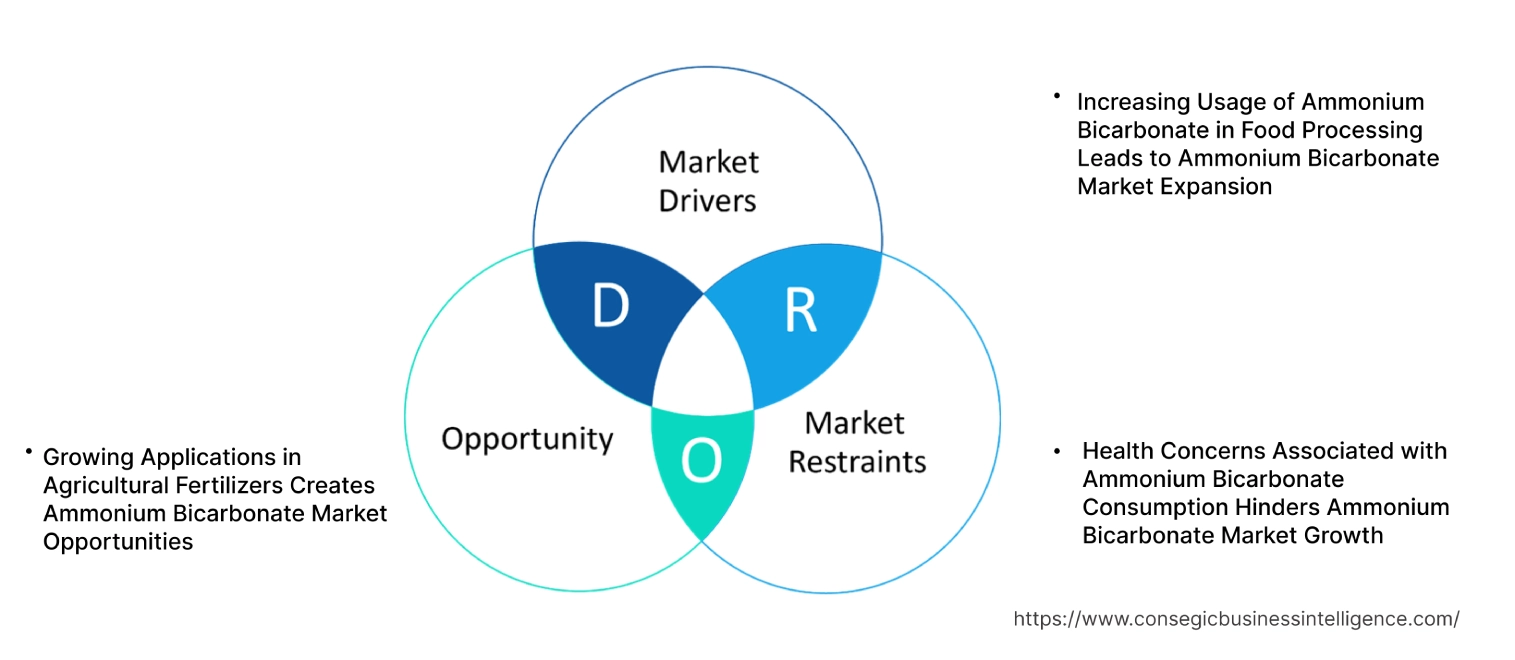Ammonium Bicarbonate Market Size:
Ammonium Bicarbonate Market size is estimated to reach over USD 1,660.04 Million by 2032 from a value of USD 1,290.35 Million in 2024 and is projected to grow by USD 1,308.65 Million in 2025, growing at a CAGR of 3.2% from 2025 to 2032.
Ammonium Bicarbonate Market Scope & Overview:
Ammonium bicarbonate is a white crystalline compound with the chemical formula NH₄HCO₃. It is an inorganic salt used across multiple industries due to its functional properties. It is highly soluble in water, decomposes at elevated temperatures, and exhibits alkaline properties. These characteristics make it versatile and effective in various applications. The compound offers several benefits, including acting as a leavening agent, buffering agent, and pH regulator. Its ability to decompose into ammonia, carbon dioxide, and water enhances its utility in processes requiring non-toxic residues. It is cost-effective and easy to handle, adding value to its industrial adoption.
Ammonium bicarbonate has applications in food processing, pharmaceuticals, agriculture, and chemical manufacturing. It is used in baking, as a fertilizer, and for producing pigments and catalysts. The end-use industries include food and beverage, pharmaceuticals, textiles, and ceramics, where they serve functional and performance-enhancing roles.
How is AI Transforming the Ammonium Bicarbonate Market?:
The integration of AI is considerably transforming the ammonium bicarbonate market. AI and automation are enhancing production capabilities in various industries, including ammonium bicarbonate sector. Moreover, AI is mainly integrated into equipment and systems used during the manufacturing of ammonium bicarbonate for optimizing production processes, improving quality control, and enhancing supply chain management.
Additionally, AI-powered systems can automate tasks such as adjusting flow rates, temperatures, and pressures in response to changing process conditions, which ensures optimum production and minimizes manual intervention. Hence, the above factors are anticipated to drive the market growth in upcoming years.
Ammonium Bicarbonate Market Dynamics - (DRO) :
Key Drivers:
Increasing Usage of Ammonium Bicarbonate in Food Processing Leads to Ammonium Bicarbonate Market Expansion
Ammonium bicarbonate is widely used as a leavening agent in the food industry, particularly in the production of baked goods and confectioneries. Its ability to release carbon dioxide upon heating makes it an essential ingredient for achieving desirable texture and volume in biscuits, crackers, and cookies. The compound's low cost and high efficacy further enhance its preference in industrial-scale baking operations. For instance, large-scale manufacturers in Asia-Pacific incorporate ammonium bicarbonate into their recipes to achieve consistent product quality and reduce production costs.
This increased adoption in food processing significantly boosts the ammonium bicarbonate market demand.
Key Restraints:
Health Concerns Associated with Ammonium Bicarbonate Consumption Hinders Ammonium Bicarbonate Market Growth
Excessive consumption of ammonium bicarbonate in food products raises health concerns, particularly regarding its impact on respiratory and gastrointestinal systems. The compound decomposes into ammonia, which, at high levels, can irritate mucous membranes and pose potential health risks to consumers. Regulatory bodies, such as the European Food Safety Authority, have imposed strict usage limits to address these concerns. For example, food manufacturers must comply with maximum allowable concentrations, which limits the quantity of ammonium bicarbonate used in recipes.
These health-related restrictions hinder its widespread application in the food industry, challenging market expansion.
Future Opportunities :
Growing Applications in Agricultural Fertilizers Creates Ammonium Bicarbonate Market Opportunities
The increasing emphasis on sustainable farming practices presents an opportunity for ammonium bicarbonate in the agricultural sector. As a nitrogen-rich compound, it is being explored for use in fertilizers to enhance soil fertility and promote plant growth. Its water solubility allows for easy absorption by plants, making it a suitable choice for precision agriculture. For instance, research initiatives in developing economies focus on formulating efficient fertilizers with ammonium bicarbonate to boost crop yields while reducing environmental impact. This emerging application is anticipated to drive future ammonium bicarbonate market growth.
Ammonium Bicarbonate Market Segmental Analysis :
By Grade:
Based on grade, the ammonium bicarbonate market is segmented into food grade, technical grade, and agriculture grade.
The food grade segment accounted for the largest revenue in ammonium bicarbonate market share in 2024.
- Food-grade ammonium bicarbonate is widely used as a leavening agent in baked goods, including cookies, crackers, and biscuits.
- It is known for its ability to produce light and airy textures while decomposing completely during baking, leaving no residual taste.
- The product is also used in food preservation due to its capacity to control microbial growth in processed foods.
- The increased global consumption of baked goods and confectioneries is increasing the ammonium bicarbonate market trend of food-grade ammonium bicarbonate.
- Additionally, food safety regulations promoting the use of safe leavening agents support its widespread adoption in the food and beverage industry.
- Therefore, according to the ammonium bicarbonate market analysis, the extensive application of food-grade ammonium bicarbonate in the baking industry contributes significantly to its dominant market position.
Agriculture grade ammonium bicarbonate is anticipated to register the fastest CAGR during the forecast period.
- It is used in fertilizers as a nitrogen source, improving soil quality and crop yield.
- Its low-cost availability and effectiveness in promoting plant growth drive its adoption in the agricultural sector.
- The rising global focus on sustainable farming practices is enhancing the trend for agriculture-grade ammonium bicarbonate.
- It is also utilized in composting applications to accelerate decomposition and nutrient recycling in organic farming.
- Furthermore, government initiatives to promote eco-friendly fertilizers bolster the growth of agriculture-grade ammonium bicarbonate.
- Thus, according to ammonium bicarbonate market analysis, the growing emphasis on agricultural productivity and cost-effective solutions supports the accelerated trend of agriculture-grade ammonium bicarbonate.
By Application:
Based on application, the ammonium bicarbonate market is segmented into baking and leavening agents, medicinal uses, fertilizer and animal feed additives, chemical manufacturing and water treatments, and others.
The baking and leavening agent segment accounted for the largest revenue share of 27.50% in the ammonium bicarbonate market share in 2024.
- Ammonium bicarbonate is preferred for its ability to provide a light and crispy texture in baked goods while decomposing fully during baking.
- It is extensively used in commercial bakeries and home baking, catering to diverse consumer preferences.
- Its cost-efficiency and compatibility with various baking recipes make it a staple in the industry.
- The product is also known for its suitability in low-moisture baked goods, enhancing its range of applications.
- The rising popularity of artisanal and specialty baked products globally contributes to the dominance of this segment.
- Therefore, according to market analysis, the established application of ammonium bicarbonate in baking underpins its significant revenue contribution to the market.
The fertilizer and animal feed additives segment is anticipated to register the fastest CAGR during the forecast period.
- In fertilizers, ammonium bicarbonate provides a quick-release nitrogen source that enhances soil fertility and plant growth.
- As an animal feed additive, it contributes to protein synthesis and metabolic functions in livestock.
- The rising focus on agricultural sustainability and livestock productivity supports the increased trend of this application.
- It is also utilized in aquaculture to promote the health and growth of aquatic species.
- Increasing research into nutrient management techniques in agriculture and livestock fosters the adoption of ammonium bicarbonate.
- Thus, according to market analysis, the increasing utilization of ammonium bicarbonate in agriculture and animal husbandry accelerates the expansion of this segment.
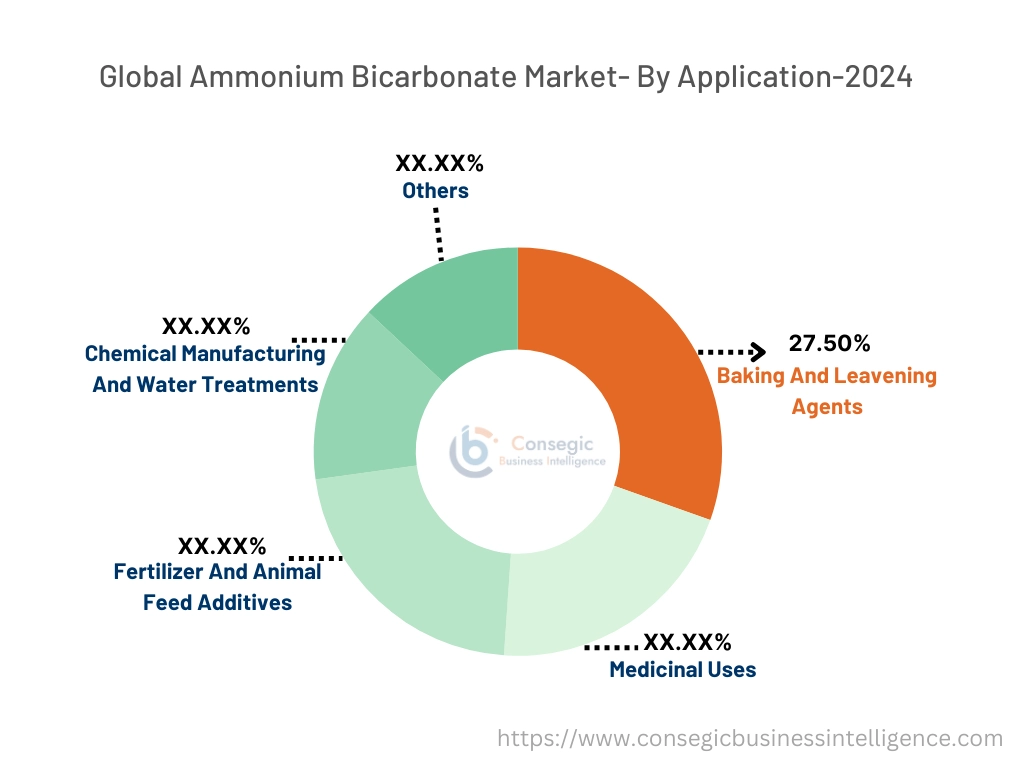
By End-User Industry:
Based on the end-use industry, the ammonium bicarbonate market is segmented into agricultural, ceramic, food and beverage, pharmaceutical, rubber and leather, textile, and others.
The food and beverage sector accounted for the largest revenue share in 2024.
- Ammonium bicarbonate is essential in the production of various baked goods, confectioneries, and snacks due to its unique leavening properties.
- It offers an economical alternative to other leavening agents while ensuring high-quality end products.
- The increased trend for processed and ready-to-eat food products bolsters its usage in the food and beverage industry.
- The product also serves as a foaming agent in beverages, contributing to its diverse functionality.
- Expanding urbanization and changing consumer preferences for convenience foods further drive its trend.
- Therefore, according to market analysis, the versatility of ammonium bicarbonate as a food additive positions the food and beverage segment as a major contributor to market revenue.
The agricultural sector is anticipated to register the fastest CAGR during the forecast period.
- The use of ammonium bicarbonate in fertilizers enhances crop growth by providing an efficient nitrogen source.
- Its application aligns with the rising global need for improved agricultural productivity to meet growing food demands.
- The adoption of sustainable farming techniques further fuels the demand in this segment.
- Ammonium bicarbonate is also used in animal feed to optimize livestock health and growth rates.
- Increasing investments in agricultural technologies and innovations contribute to its ammonium bicarbonate market growth.
- Thus, according to market analysis, the critical role of ammonium bicarbonate in enhancing crop yield propels the rapid growth of its usage in the agricultural sector.
Regional Analysis:
The regional segment includes North America, Europe, Asia Pacific, the Middle East and Africa, and Latin America.
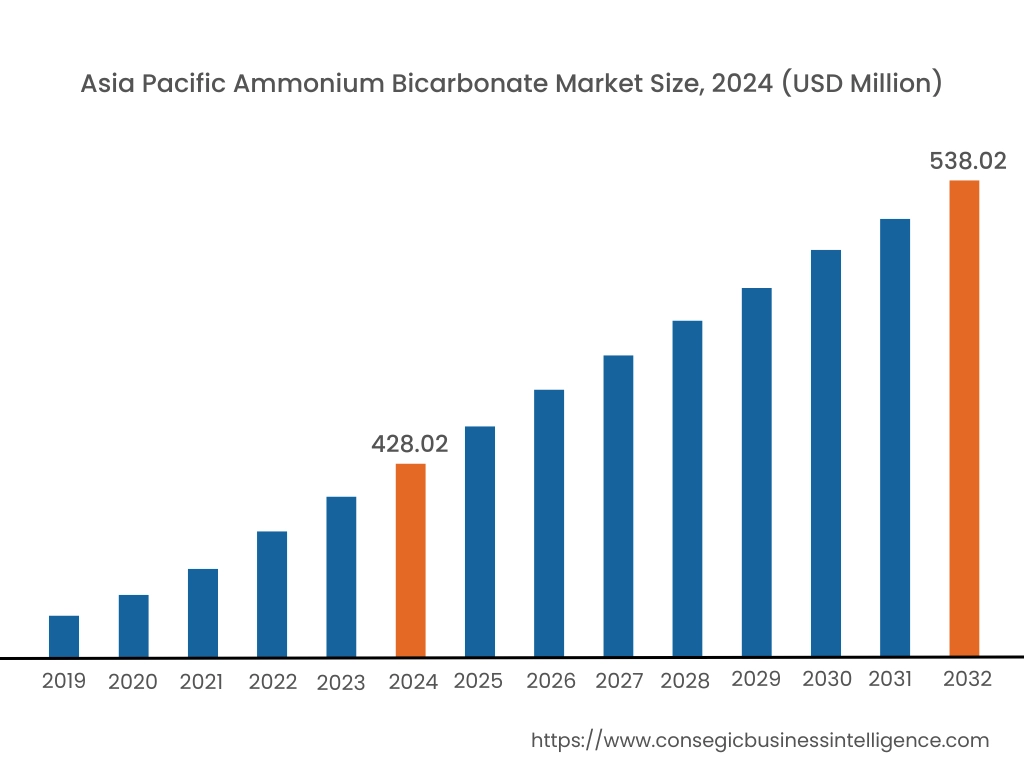
In 2024, North was valued at USD 428.02 Million and is expected to reach USD 538.02 Million in 2032. In North America, the U.S. accounted for the highest share of 71.80% during the base year of 2024. In North America, the ammonium bicarbonate market is stable, with the United States and Canada being key contributors. The trend for ammonium bicarbonate is primarily driven by its use in agriculture as a nitrogen fertilizer. The region's strong agricultural industry, particularly in crop production, supports steady demand. Additionally, the increasing focus on sustainable farming practices and organic fertilizers contributes to market dynamics. North America's well-established chemical manufacturing infrastructure further enhances market accessibility and growth.
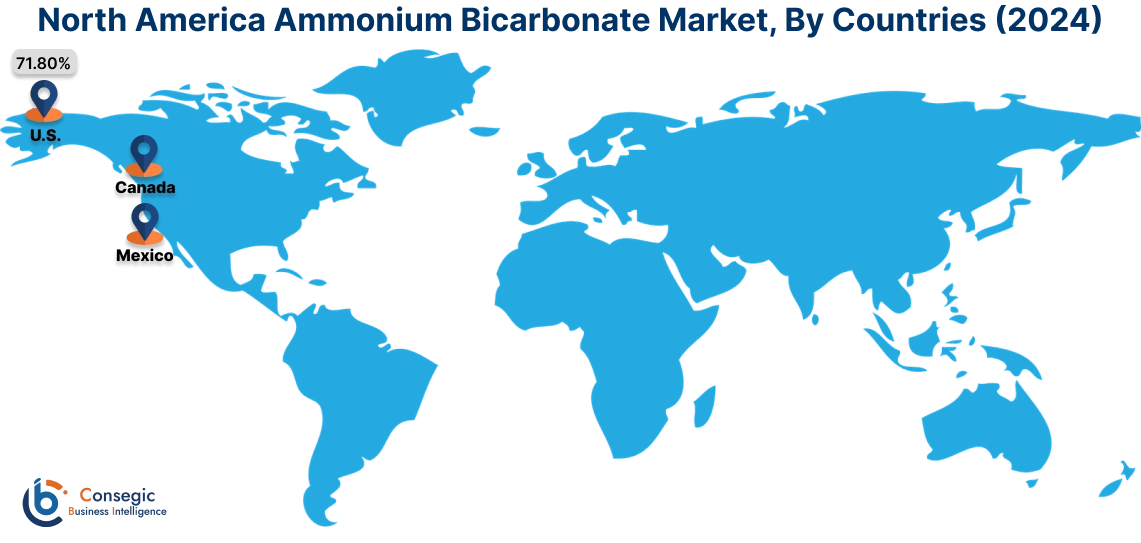
In Asia Pacific, the market is experiencing the fastest growth with a CAGR of 3.6% over the forecast period. Asia-Pacific is the largest market for ammonium bicarbonate, led by countries such as China, India, and Japan. The demand in this region is fueled by the agricultural sector, where ammonium bicarbonate is widely used as a fertilizer to enhance soil quality and increase crop yields. China, as a major producer and consumer, significantly impacts market performance. Additionally, the growing focus on improving agricultural productivity and food security in India and Southeast Asia further boosts the trend. The region’s expanding industrial base also contributes to the increased use of ammonium bicarbonate in other sectors like food processing and pharmaceuticals.
Europe’s ammonium bicarbonate market shows steady demand, driven by agricultural applications. Key countries include Germany, France, and the UK. The region’s advanced agricultural technologies, along with a high focus on sustainable farming, increase the demand for ammonium bicarbonate as an eco-friendly fertilizer. Europe also places a strong emphasis on environmental regulations, which promote the use of safer chemical products. Additionally, the rising demand for ammonium bicarbonate in food applications, such as baking powder and as a leavening agent, supports market stability.
The Middle East and Africa exhibit moderate demand for ammonium bicarbonate, with countries like South Africa, Saudi Arabia, and Egypt showing increased consumption. The region’s agricultural industry, though smaller compared to Asia-Pacific, uses ammonium bicarbonate for crop production, especially in countries with large farming sectors. In the Middle East, the growing emphasis on food security and agricultural sustainability fuels demand. However, market growth is constrained by limited local production capacities and reliance on imports. The region’s focus on improving agricultural yields through innovative fertilizers influences the ammonium bicarbonate market in this area.
In Latin America, countries like Brazil and Argentina are the primary markets for ammonium bicarbonate, with the demand largely driven by agricultural applications. The region’s vast agricultural sector, particularly in crop farming and livestock production, heavily relies on ammonium bicarbonate as a nitrogen-based fertilizer. The expansion of organic farming practices and government support for sustainable agriculture contribute to market stability. The market in Latin America is also supported by increased food production and export needs, where ammonium bicarbonate plays a key role in enhancing crop productivity.
Top Key Players and Market Share Insights:
The global ammonium bicarbonate market is highly competitive with major players providing products to the national and international markets. Key players are adopting several strategies in research and development (R&D), product innovation, and end-user launches to hold a strong position in the global ammonium bicarbonate market. Key players in the ammonium bicarbonate industry include-
- Yunnan Tin Company Limited (China)
- Nutrien Ltd. (Canada)
- Jiangsu Jiuzhou Chemicals Co., Ltd. (China)
- Agroliquid (United States)
- Solvay S.A. (Belgium)
- Shandong Hualu-Hengsheng Chemical Co., Ltd. (China)
- Samsung Fine Chemicals Co., Ltd. (South Korea)
- China National Petroleum Corporation (CNPC) (China)
- Hubei Xingfa Chemicals Group Co., Ltd. (China)
- Koch Industries, Inc. (United States)
Ammonium Bicarbonate Market Report Insights :
| Report Attributes | Report Details |
| Study Timeline | 2019-2032 |
| Market Size in 2032 | USD 1,660.04 Million |
| CAGR (2025-2032) | 3.2% |
| By Grade |
|
| By Application |
|
| By End-User Industry |
|
| By Region |
|
| Key Players |
|
| North America | U.S. Canada Mexico |
| Europe | U.K. Germany France Spain Italy Russia Benelux Rest of Europe |
| APAC | China South Korea Japan India Australia ASEAN Rest of Asia-Pacific |
| Middle East and Africa | GCC Turkey South Africa Rest of MEA |
| LATAM | Brazil Argentina Chile Rest of LATAM |
| Report Coverage |
|
Key Questions Answered in the Report
How big is the Ammonium Bicarbonate Market? +
In 2024, the Ammonium Bicarbonate Market was USD 1,290.35 million.
What will be the potential market valuation for the Ammonium Bicarbonate Market by 2032? +
In 2032, the market size of the Ammonium Bicarbonate Market is expected to reach USD 1,660.04 million.
What are the segments covered in the Ammonium Bicarbonate Market report? +
The grade, application, and end-user industry are the segments covered in this report.
Who are the major players in the Ammonium Bicarbonate Market? +
Yunnan Tin Company Limited (China), Nutrien Ltd. (Canada), Shandong Hualu-Hengsheng Chemical Co., Ltd. (China), Samsung Fine Chemicals Co., Ltd. (South Korea), China National Petroleum Corporation (CNPC) (China), Hubei Xingfa Chemicals Group Co., Ltd. (China), Koch Industries, Inc. (United States), Jiangsu Jiuzhou Chemicals Co., Ltd. (China), Agroliquid (United States), Solvay S.A. (Belgium) are the major players in the Ammonium Bicarbonate market.
